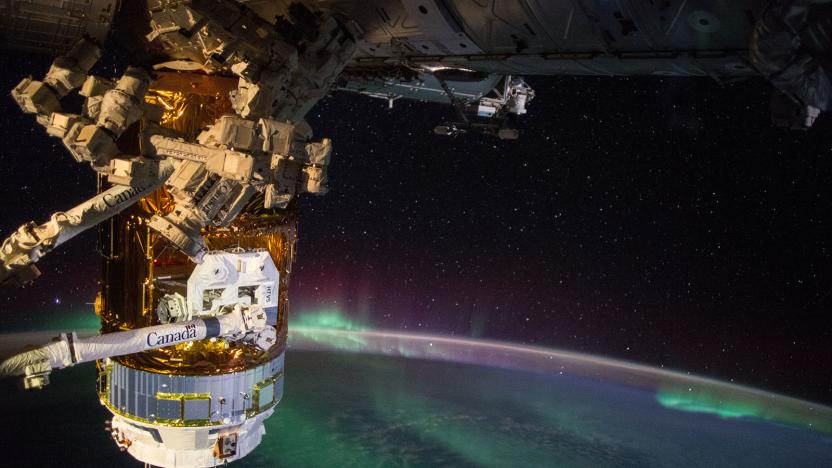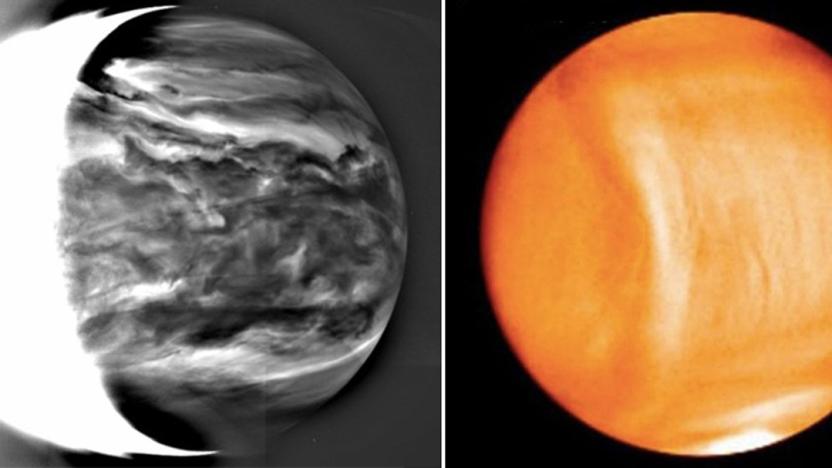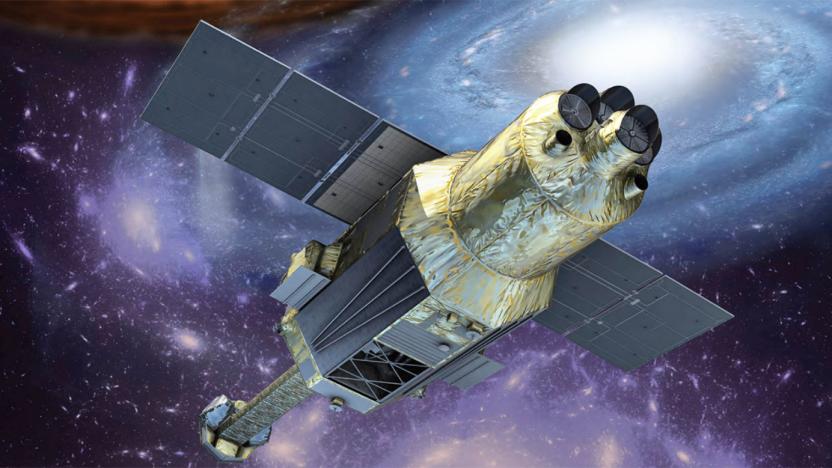JAXA
Latest

Japanese cargo ship set to dock with the ISS at 4:30 AM ET
Less than two weeks after Russia's Progress 65 ISS cargo ship blew up on route to the International Space Station (ISS), the Japanese Space Agency (JAXA) is coming to save the day. After a successful launch, JAXA's Kounotori ("White Stork") HTV-6 has caught the ISS and is slowly moving toward the Harmony Module. Crew members Shane Kimbrough and Thomas Pesquet, stationed in the "Cupola," will use the Canadarm2 to wrangle it onto Harmony's Earthward dock. NASA will broadcast the attempt starting at 4:30AM ET, with the initial capture around 6AM ET. Broadcast of the final docking will start at 9:15 AM.

Japanese spacecraft lifts off with ISS supplies on board
The ISS crew won't have to worry about running out of supplies this holiday season. Japan's space agency loaded its ship called Kounotori 6 with 4.5 tons of food, water, spare parts and experimental hardware before sending it off to the ISS on top of an H-IIB rocket. Over a week ago, the Russian spacecraft that was supposed to ferry everything astronauts need to the orbiting lab burned up a few minutes into its journey. It's still unclear why the spacecraft disintegrated, but it apparently has something to do with the Soyuz rocket's third stage.

Hitomi observed the Perseus galaxy cluster before it died
Japan's most powerful x-ray satellite Hitomi got lost in space shortly after it launched, but it managed to beam back data that can help us better understand galaxy clusters. The space telescope got a chance to peer into a cluster of galaxies and its supermassive black hole in the Perseus constellation using the Goddard-built Soft X-Ray Spectrometer. Thanks to the data it sent back, astronomers found that the massive cluster's center has a "remarkably quiescent atmosphere" with fewer stars than they thought it would have.

Japan's most powerful X-ray satellite is dead
JAXA has given up trying to rescue its doomed X-ray satellite. The Japanese space agency has announced that it's discontinuing Hitomi's operations. Previously known as Astro-H, the x-ray observatory was designed to study black holes, galaxy clusters and other high-energy phenomena. Unfortunately, it started tumbling and spinning through space shortly after launch, ultimately losing contact with its ground team. JAXA thought the $300 million spacecraft tried to re-establish contact, but in its announcement today, the agency revealed that the signals it received were from another source altogether.

Venus probe's first detailed results reveal strange clouds
Japan's Akatsuki spacecraft almost didn't make it into orbit around Venus, but it's clear that the effort to put it back on track is paying off. The Japan Aerospace Exploration Agency recently obtained the first detailed scientific results from its once-wayward probe, and it's clear that we still have a lot to learn about our closest planetary cousin. For one thing, its clouds don't entirely behave the way researches expect. Infrared images of its dense, multi-layer cloud layers suggest that cloud formation is more complex than once thought, and the unusual bow-shaped cloud formation (shown at right) appears to rotate in sync with the surface, not the atmosphere. It's possible that features on the ground are having a strong effect on the sky.

Japan is trying to rescue its tumbling X-ray satellite
Japan's JAXA space agency is struggling to figure out what happened to its Astro-H "Hitomi" satellite after it lost contact on Saturday. Radar data from the US Strategic Command's Joint Space Operations Center (JSpOC) initially showed that several parts may have broken off and JAXA's radar has spied at least one separated piece. Yesterday, scientists received intermittent signals from the craft, showing that it might be at least partially functional. However, amateur video now appears to show the $360 million X-ray telescope-equipped craft tumbling through space.

Japan's most powerful X-ray satellite went incommunicado
Japan's space agency launched its latest X-ray satellite Hitomi in February, expecting it to keep an eye on the universe for at least three years. Sadly, its future is now uncertain. JAXA lost contact with the observatory (previously called Astro-H) this weekend, and it's still trying to find out what happened to its $270 million mission. Astronomers realized something was wrong when Hitomi failed to phone home for a routine check on Sunday, March 27th, 3:40AM Eastern time. The US Joint Space Operations Center reported afterward that it spotted five pieces of debris in Hitomi's location before JAXA was supposed to hear from the satellite.

Japan's X-ray satellite Astro-H will soon blast off to space
Japan Aerospace Exploration Agency's (JAXA) newest (and sixth!) X-ray observatory is leaving for space on Friday to study black holes and galaxy clusters. It's called Astro-H, and it's blasting off with several scientific instruments in tow. These include ones that can detect X-ray sources 10 times fainter than what its predecessor, the Suzaku, could detect. The star of the show, though, is its Soft X-Ray Spectrometer (SXS), which is fitted with a "microcalorimeter." The Goddard-built spectrometer (designed in cooperation with various Japanese institutions) will use that device to measure and distinguish X-ray colors.

Japan's Akatsuki probe successfully makes it into Venus' orbit
After five years of orbiting the sun, Japan Aerospace Exploration Agency's (JAXA's) Akatsuki probe has finally reached the destination it was gunning for from the start. JAXA has confirmed that the spacecraft has been successfully inserted into Venus' orbit, flying in the same direction as the planet's rotation. Akatsuki's first attempt in 2010 ended in failure, because its engines fired for less than three minutes, which wasn't enought to inject it into the Morning and Evening star's orbit. It had to be placed into hibernation mode to prolong its lifespan until JAXA had the chance to make another attempt a few days ago.

Japan's Venus probe is about to take another shot
Japan tried and failed to get its Akatsuki ("Dawn") probe into Venus' orbit back in 2010, and the spacecraft has been stuck orbiting the Sun ever since. However, the team is about to get another chance at completing its intended mission. Controllers plan to fire the ship's engines on December 7th at 9AM Japan time (December 6th 7PM ET), hopefully giving it just enough of a push to (eventually) get it circling around Venus. They'll know whether or not the burn worked properly within a few hours, but it'll take a few days before they know if they're in orbit.Update: The attempt is happening in just a few minutes, for live updates you can watch a stream of the data and control center, or follow Emily Lakdwalla on Twitter.

Japan is planning an unmanned moon mission for 2019
Japan's space program announced today that it wants to become the fourth country to successfully land an unmanned vessel on the moon. The scheduled launch date is planned for 2019 and even though it seems like the world is focused on Mars and beyond right now, Japan wants to show off the latest in lander technology. The craft will use facial recognition software to drastically increase landing accuracy. The on-board technology can scan the surface of the Moon and make slight adjustments to touch down within 100 meters of the target landing site -- that's dramatically better than anything America, China or Russia have launched. Completing this project will help beef up the country's standing in space exploration. With this said, if it has taken this long for Japan to reach the moon, wonder what year they're going to get to Mars?

Scientists make strides in beaming solar power from space
The idea of powering humanity by gathering an endless supply of solar energy from space has taken a huge step towards becoming a reality. Scientists working for JAXA, Japan's space administration, have announced a major breakthrough in wireless power transmission ... in that they've actually been able to do it with a high degree of accuracy for once. The team reportedly beamed 1.8 kilowatts, enough juice to power an electric tea kettle, more than 50 meters to a small receiver without any wires. Up next: scaling the technology for use in tomorrow's orbital solar farms.

Japan's Hayabusa 2 spacecraft heads to a carbon-rich asteroid soon
On November 30th, Japan's Hayabusa 2 will be leaving leaving Earth aboard a Mitsubishi-made rocket to make its way to an asteroid -- but not to blow it up. The Japanese spacecraft will follow in its predecessor's footsteps and observing a space rock for science (of course). But unlike the first Hayabusa that explored an asteroid rich in silicate and nickel-iron, this one's headed for one that's made of clay and rocks: materials that could contain organic matter and water. The unmanned vehicle will traverse outer space for more than three years until it finds asteroid "1999 JU3," which it's scheduled to reach by June 2018.

The early design history of NASA's spacesuits
In Japan, Space Expo 2014 has begun. It's a collaboration between the country's Aerospace Exploration Agency (JAXA) and NASA, offering a chance for the public to see over 500 pieces of space exploration-themed realia. This includes shuttle replicas, for-real space food samples and a whole lot of rockets -- which is one of JAXA's specialties. In the middle of the exhibition, which lasts through September 2014, the Space Expo tells the story of the not-so-humble spacesuit.

Japan's Epsilon rocket with onboard AI successfully launches
Affordable is a relative term, but in the world of rocket science Japan's recently launched Epsilon qualifies as such. Costing just $37-million (albeit not directly comparable, NASA claims a typical launch costs around $450-million) to send off, Jaxa -- Japan's space agency -- rightly considers it a steal. Epsilon launched from the south-west of the country at 2pm local time. Its mission? To deploy a telescope that Jaxa advises will observe our neighboring planets from its position in Earth's orbit. The cost efficiency is being put down to the rocket's artificial intelligence, something that slashes the man-power needed from 150 to 8. Let's just hope the thriftiness wasn't just to fund that other recent launch.

Japanese robots Kirobo and Mirata set for launch, literally
Don't get excited about buying the new robots created by Japanese company Dentsu in conjunction with Toyota and the University of Tokyo -- they won't be hitting stores anytime soon. However, do get excited that one of them, namely the white-helmeted droid Kirobo (shown above, left), will actually be launched into orbit as part of a Japan Space Agency mission to the ISS on August 4th. In fact, he and his backup Mirata were endowed with voice recognition, natural language processing, speech synthesis, realistic body language and facial recognition for that very reason. They'll be participating in the "world's first conversational experiment" between people and robots in space, while also mixing it up with kids on earth with educational activities. Hopefully, the astronauts won't give Kirobo any HAL 9000-like control of the station, though the cute 'bots seem malice-free, saying they "wanted to create a future where humans and robots live together and get along." Check it out for yourself in the video after the break.

Visualized: Cubesat micro-orbiters slip into space to flash Earth in Morse code
Japan's four-inch FITSAT-1 orbiters were released from Japan's Kibo laboratory on the ISS last week to (literally) start their world tour, and astronauts aboard the station captured the wee satellites being dwarfed by giant solar arrays and our own blue rock on their way to orbit. Soon they'll be writing "Hi this is Niwaka Japan" in Morse code using intense flashes of LED light, first to Japan and then across the globe, starting next month. To catch them floating away from the International Space Station's cozy confines, hit the source.

Japan's LED-stacked cubesat will burn Morse code into the heavens
If you thought cloud writing was cool, then how about a message from space burnt into the night sky? A group of unassuming cubesats recently left the comfort of the ISS and joined Earth's orbit -- among them was FITSAT-1 (aka Niwaka), a four-inch-cubed Japanese satellite covered in high-powered LEDs. Its mission is to broadcast the message "Hi this is Niwaka Japan" in Morse code, using bursts of intense light to draw dots and dashes across the heavens. FITSAT-1 was originally planned to appear only over Japan, but a flurry of interest means it'll be touring the globe, starting next month. It'll also find time for its studies, beaming VGA images snapped with an onboard camera back to Earth, to test a high-speed data transmitter. While its creator, Professor Takushi Tanaka, has said the Morse broadcast has "no practical aim," we think it would make a good emergency beacon for natural disasters (or, more worryingly, alien invasions). FITSAT-1 will try and fulfill all requests for appearances, but it can't control the weather, so you'd better hope for a clear night if it visits your part of the world. If you're as excited as we are to see it in action, bookmark the source links below, which should be updated with its orbit schedule in the near future. And, even if you don't speak Japanese, the video after the break will give you an idea of what to expect.

Japanese spacecraft's 'black box' recorder survives flaming fall to earth
When we reported on Japan's plans to track the re-entry process of its Kounotori 2 spacecraft with a black-box-style recorder, there were still some unanswered questions: specifically, would the REBR (Re-entry Breakup Recorder) sink or swim. Well, according to an announcement from the device's creator, the thing not only survived the fiery plunge to Earth, but it also stayed afloat after plunking down in the South Pacific Ocean on Tuesday. During free fall, the REBR did as it was expected, automatically monitoring, recording, and eventually transmitting data about the re-entry process, and while the thing was admittedly "not designed to survive impact with the water," it continued relaying information even after landing. The next scheduled REBR mission is planned for June -- here's hoping the new guy's as buoyant as its buddy. Full PR after the break.

Japan sends Kounotori 2 spacecraft on suicide mission to study re-entry process
An unmanned cargo ship built by the Japan Aerospace Exploration Agency (JAXA) is set to go up in flames tomorrow in the name of interplanetary research. Along with a load of space station junk, the Kounotori 2 spacecraft is packing something akin to a black box, also known as a Re-entry Breakup Recorder (REBR), that will collect and transmit data about the ship's final moments. The space station's crew will activate the REBR before Kounotori 2 begins its final assignment. As soon as it starts showing signs of re-entry, the sensor will begin to collect data including temperature, acceleration, and rotation rate, and will then break away from the craft for a final free fall to Earth, at which point the REBR will dump its findings. Scientist hope the device will help answer questions about exactly what happens when things fall apart during re-entry. If all goes according to plan, the REBR will plunk down in the ocean sometime later, but its host will never be seen again... farewell, Kounotori 2.








